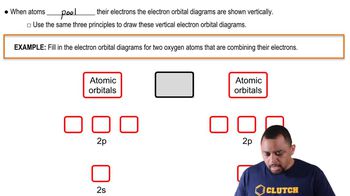Dichloroethylene (C2H2Cl2) has three forms (isomers), each of which is a different substance. (c) How many isomeric forms can chloroethylene, C2H3Cl, have? Would they be expected to have dipole moments?
Ch.9 - Molecular Geometry and Bonding Theories
Chapter 9, Problem 46b,c
Draw sketches illustrating the overlap between the following orbitals on two atoms: (b) the 2pz orbital on each atom (assume both atoms are on the z-axis) (c) the 2s orbital on one atom and the 2pz orbital on the other atom.
 Verified step by step guidance
Verified step by step guidance1
Start by understanding that the 2pz orbitals are oriented along the z-axis, which means they extend above and below the nucleus along this axis.
Visualize each 2pz orbital as a dumbbell shape with two lobes, one above and one below the nucleus, aligned along the z-axis.
Consider the two atoms positioned along the z-axis, with their nuclei aligned. The 2pz orbitals from each atom will face each other.
Sketch the two 2pz orbitals such that their lobes overlap along the z-axis. The overlap occurs between the lobes of the orbitals that are facing each other.
Label the sketch to indicate the positive and negative phases of the orbitals, as this is important for understanding the type of bond (sigma or pi) that may form due to the overlap.

Verified video answer for a similar problem:
This video solution was recommended by our tutors as helpful for the problem above.
Video duration:
1mWas this helpful?
Key Concepts
Here are the essential concepts you must grasp in order to answer the question correctly.
Atomic Orbitals
Atomic orbitals are regions in an atom where there is a high probability of finding electrons. They are defined by quantum numbers and have distinct shapes, such as s, p, d, and f orbitals. The 2pz orbital, for example, is a type of p orbital that is oriented along the z-axis and has a characteristic dumbbell shape, which is crucial for understanding how atoms interact and bond.
Recommended video:
Guided course

Atomic Orbitals Example
Orbital Overlap
Orbital overlap occurs when atomic orbitals from two atoms come into proximity, allowing their electron clouds to interact. This overlap is fundamental to the formation of covalent bonds, as it enables the sharing of electrons between atoms. In the case of two 2pz orbitals overlapping, the extent and nature of this overlap can influence the strength and characteristics of the bond formed.
Recommended video:
Guided course

Molecular Orbital Theory
Molecular Geometry
Molecular geometry refers to the three-dimensional arrangement of atoms within a molecule, which is influenced by the types of bonds and the spatial orientation of the orbitals involved. The overlap of the 2pz orbitals on two atoms will affect the overall shape of the molecule, as well as its physical and chemical properties. Understanding molecular geometry is essential for predicting how molecules will interact in chemical reactions.
Recommended video:
Guided course

Molecular Geometry with Two Electron Groups
Related Practice
Textbook Question
Textbook Question
Dichlorobenzene, C6H4Cl2, exists in three forms (isomers) called ortho, meta, and para:
Which of these has a nonzero dipole moment?
Textbook Question
Draw sketches illustrating the overlap between the following orbitals on two atoms: (a) the 2s orbital on each atom
Textbook Question
For each statement, indicate whether it is true or false. (d) Nonbonding electron pairs cannot occupy a hybrid orbital.
Textbook Question
Consider the molecule BF3. (c) What hybrid orbitals should be constructed on the B atom to make the B–F bonds in BF3?
Textbook Question
Consider the SCl2 molecule. (c) What hybrid orbitals should be constructed on the S atom to make the S-Cl bonds in SCl2?
